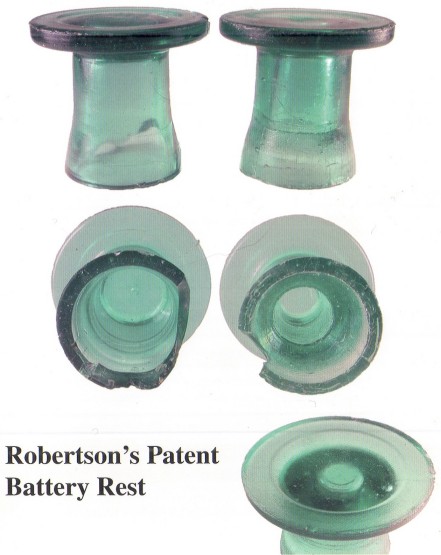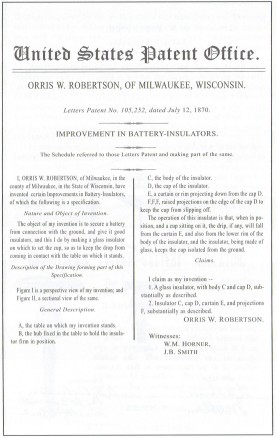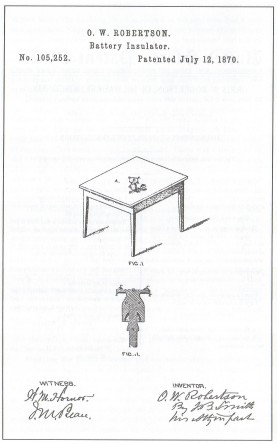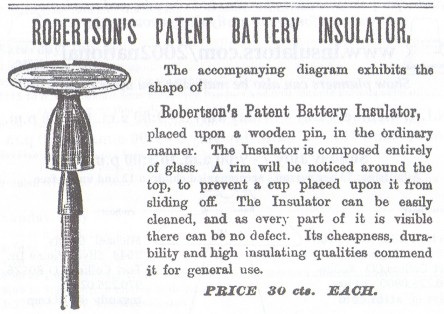Robertson's Patent Battery Insulator
by Dwayne Anthony
Reprinted from "Crown Jewels of the Wire", May 2002, page 17
The two battery insulators showcased on this month's magazine cover and in
this article, along with a third specimen, were dug approximately two years ago
from an outhouse pit in St. Paul, Minnesota. Shortly thereafter, a listing for
an "old threadless insulator" appeared on eBay. The text described the
insulator as a rare unknown type and the accompanying photo pictured an odd
mushroom shaped aqua glass object with what appeared to be a threadless pinhole.
|

COVER: The photos on the cover were taken by Dwayne Anthony who
shares the story of the Robertson's Patent Battery Insulator beginning on
page 17 of this issue.
On the top left, the large pinhole variation is pictured next to the
smaller pinhole type to the right. In the middle you find a picture taken
from the base looking into the pinhole of the each of the battery rests.
The flat top battery rest was described as "an odd mushroom shaped
aqua glass object with what appeared to be a threadless pinhole." |
Even though I couldn't quite put my finger on it, there was something vaguely
familiar about the peculiar design of this object. Staring at the photo I
immediately began the often-frustrating process of recollecting elapsed data
from the deepest nodes of the memory banks. Then the mental revelation suddenly
came to view! I recalled a visit to the home of good friend and collector, Dario
Dimare, back during the Marlborough National Show in 1995. While looking through
an early L.G. Tillotson catalog from his extensive library, Dario had pointed
out an ad for a bizarre shaped battery insulator. At the time, a larger mushroom
shaped threadless insulator with a reconstructed top, embossed M. T. Co., had
been assigned a new threadless CD number. Dario was commenting on the general
similarity of the M. T. Co. and the battery insulator in the ad. It was this
recollection of the rough rendering in the Tillotson ad, depicting a flat topped
mushroom shaped insulator, that prompted me to pursue the eBay insulator
further. (FYI: the M.T. Co. "threadless" was later reassigned a new CD
number under the battery insulator classification: CD 61.)
Armed with the notion
that it could possibly be a unique early telegraph era battery insulator, the
figurative dice were tossed with a bid submission. Soon to follow were the
typical withdrawal pains of wishing a higher bid had been submitted, as I
helplessly watched it close to a higher bidder within the final seconds of the
auction.
Undaunted by the acquisition loss, I just had to investigate further.
Contact was made with the seller to prod for any clues that may assist in
identifying its heritage. A final note was added to the email message: "If
you happen upon another, I am interested."
Within hours the exciting news appeared in his reply -- he had a second
specimen! Negotiations then ensued and the second example was procured. During
the closing of the deal it was mentioned that a third specimen was also found,
but had some rather major damage to the "skirt" area. In the
description of this third specimen it was noted that it had a much larger
pinhole than the other two. Negotiations were again quickly placed into motion
and the third example was eventually acquired as well.
During further
communications with the seller, who was one of three diggers involved in the
discovery of the three insulators, the following information was given: "We
obtained access to an older area of St. Paul on the old Stillwater Road
Stagecoach Line. This road also had a telegraph line installed about 1855 and it
seems some of the insulators went into the local privies. There was a listing
in an old 1860 city directory for a telegraph operator and office in the area of
the dig. In addition to the battery insulators, we've found assorted broken CD
718's, 732's and one unknown style. We've also found quite a few historical
flasks and some early blob sodas, plus pontiled pickles and sauces."
These
insulators were indeed from an early site. The seller also provided a portion of
an insulator that was found in the same outhouse hole; it was a gorgeous forest
green CD 718 threadless! Immediately upon acquiring the two specimens, an email
was sent to Dario requesting a copy of the ad. On a whim, I also contacted Elton
Gish to see if he had by any chance run across such an insulator in his
extensive library of patents. It was a pleasant surprise to hear that he did
indeed have patent information on a battery insulator that very much matched my
description of a "mushroom shaped threadless insulator" and it would
be in the mail pronto! Once the patent office copies arrived, there was little
doubt that the insulators matched patent No. 105,252, issued on July 12, 1870
for a battery insulator designed by O. W. Robertson. The 1872 Tillotson ad
arrived a short time thereafter, illustrating a battery insulator by Robertson,
which further solidified the similarity!
Studying the patent drawing and
accompanying specifications, this insulator was specifically designed for
mounting on a threadless pin, which in turn was mounted on a table. When
comparing the patent drawing with the Tillotson ad drawing, you will note some
slight design deviations, primarily in the "cap" rim projections. This
is also apparent when comparing the patent drawing with the actual specimens. It
is not an unusual occurrence to see minor design alterations in a final
manufactured product. In some cases this was due to modifications required by the mold makers and manufacturers.
The most interesting
and puzzling modification is the one found on the specimen with the larger inner
skirt opening. Was this a feature intended for a different mounting application,
or possibly a later design improvement?

Medium Image (94 Kb)
Large Image (200 Kb)

Medium Image (94 Kb)
Large Image (200 Kb)
Another interesting bit of relevant
information is found with Robertson's city of residence, versus the location in
which the insulators were found. The inventor, Orris W. Robertson, was a
resident of Milwaukee, Wisconsin, at the time the patent was issued. The
insulators were found in St. Paul, Minnesota, just a mere 300 miles from
Milwaukee. Maybe Robertson canvassed the local cities in his region, visiting
telegraph offices to promote his wares, even possibly leaving samples behind?
In
summation, and from all the evidence gleaned, these battery insulators are of
early 1870s vintage and were probably discarded in the mid to late 1870s. Based
on their rarity, it is unlikely that they saw widespread usage. One additional
specimen with the larger interior opening has been confirmed and appears to have
come from a different source. So, of the four reported specimens, two are
designed to accept a standard threadless pin, per the original patent design:
the other two contain the larger "non pin" open inner skirt. Original
cost in the Tillotson catalog was 30 cents each. Dimensions are: 3-1/4 H x
3-1/2 W. The manufacturer is currently unknown. A CD num-
(remainder of article text missing from original copy)

1872 Tillotson catalog ad.
| 